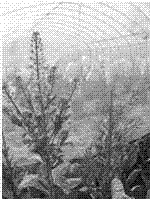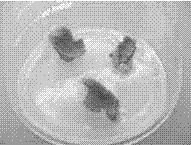A method for doubling of cabbage microspore haploid plants
A technology of microspores and haploids, applied in botany equipment and methods, horticultural methods, plant regeneration, etc., can solve the problems of inability to double the doubling efficiency of cabbage haploid plants, and solve the problems of inability to double or low doubling efficiency, The effect of high doubling efficiency and large regeneration number of adventitious buds
- Summary
- Abstract
- Description
- Claims
- Application Information
AI Technical Summary
Problems solved by technology
Method used
Image
Examples
Embodiment 1
[0023] A method for doubling double haploid of cabbage microspore haploid, is characterized in that, comprises the following steps:
[0024] 1. Selection of explants
[0025] Microspore seedlings were obtained by culturing cabbage microspores. They were transplanted into plastic greenhouses before winter to make them go through vernalization. The microspore plants bolted and bloomed in the next spring. Plant ploidy was identified by plant morphology, flower organs and stomatal guard cell chloroplast numbers, and the plants grew weakly. , narrow and long leaves, small flowers, no pollen is a haploid plant. Select the young leaves of the stems of the microspore haploid plants and cut them into 1cm 2 The left and right pieces were used as explants for in vitro culture.
[0026] 2. Preparation of colchicine and 6-benzylaminoadenine (6-BA) mother solution
[0027] It includes the following steps:
[0028] 1) Preparation of colchicine mother liquor
[0029] ① Weigh 1 gram of co...
PUM
 Login to View More
Login to View More Abstract
Description
Claims
Application Information
 Login to View More
Login to View More - R&D
- Intellectual Property
- Life Sciences
- Materials
- Tech Scout
- Unparalleled Data Quality
- Higher Quality Content
- 60% Fewer Hallucinations
Browse by: Latest US Patents, China's latest patents, Technical Efficacy Thesaurus, Application Domain, Technology Topic, Popular Technical Reports.
© 2025 PatSnap. All rights reserved.Legal|Privacy policy|Modern Slavery Act Transparency Statement|Sitemap|About US| Contact US: help@patsnap.com



